In order to prepare for the next pandemic, the government has decided on new "National Action Plan for Novel Influenza, etc.," through a decision taken at a Cabinet meeting on July 2. This is the first major shake-up in a decade, considering the experience of the COVID-19 pandemic. The new plan is designed to address crises caused by various infectious diseases, including new strains of COVID and influenza.
Pandemics, by their nature, occur unannounced. Because of this, the new plan is focused on enhancing "readiness in normal times." This involves preparing the medical system to deal with the risk of recurring epidemic waves. The new plan also states that the government may take strong measures, including declaring a state of emergency, even when scientific findings are not fully available. There were no provisions to revise the previous plan for long, even during the COVID-19 pandemic. Therefore, it will be reviewed every six years.
Yoshitaka Shindo, Minister in charge of Infectious Disease Crisis Management, said at a press conference after the Cabinet meeting that, "We will promote effective drills during normal times, careful publicity, and cooperation between the national and local governments. We will take all possible measures to effectively respond to the next infectious disease crisis."
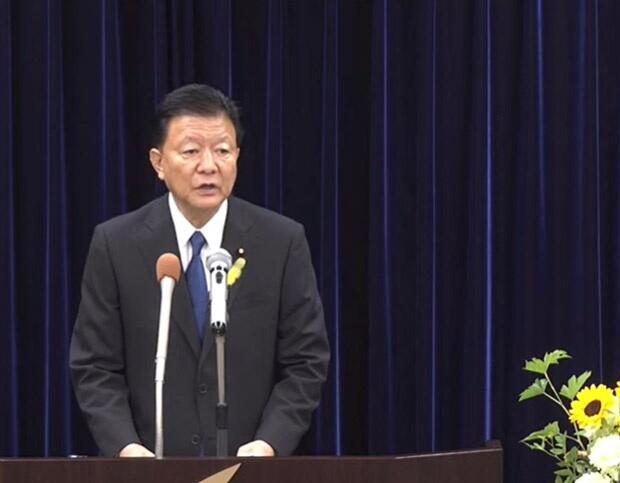
Provided by the Cabinet Agency for Infectious Disease Crisis Management
COVID-19 is currently on the trend of gradually rising. People's daily lives have returned to normal as before the pandemic, but the virus has not disappeared. The possibility of occurrence of a new pandemic in the future cannot be ruled out. Based on the lesson learned from the bitter experience of COVID-19, the government, local governments, and medical and health institutions across Japan must work together for the optimum effectiveness of the new plan.
"Border control" and "inspections" among the new plan's 13 themes
The previous plan was formulated in 2013, in response to the 2009 global swine flu pandemic. It was geared toward new strains of influenza. It was assumed that the epidemic would subside in a relatively short period of time. Therefore, it was criticized for not functioning adequately against the potential COVID outbreaks. The new plan is much more extensive. It is a document of more than 200 pages, more than twice as long as the previous plan. It is the work of the government's "Council for the Promotion of Countermeasures against Novel Influenza, etc." The Council held a series of meetings from September of last year to discuss and compile the new plan. This work was headed by the Chairperson, Takashi Igarashi, President of the National Center for Child Health and Development.

Provided by the National Center for Child Health and Development
The new plan approved by the Cabinet clearly states at its beginning, "We aim to create a society that can respond to various infectious disease crises, considering the issues that have become clear due to COVID-19 pandemic and related legal reforms." Its most significant feature is the "enhancement of preparedness in normal times."
Specifically, the government and relevant local government agencies nationwide "will conduct effective drills during normal times and constantly inspect and improve them." Additionally, local governments are asked to conclude agreements with relevant organizations in case of an outbreak of infectious diseases. In the event of an actual outbreak, medical and testing systems are to be promptly set up. The new plan also highlights the importance of creating systems for daily cooperation and networking.
The themes to be addressed are categorized into 13 independent items, including "Implementation system," "Information collection and analysis," "Providing and sharing information and risk communication," "Border measures," "Prevention of spread," "Vaccines," "Medical care," "Therapeutics," and "Testing." To flesh out the plan, the 13 items are further subdivided into three phases: preparation, initial action, and response. The aim is to envision multiple waves of infection and switch between countermeasures depending on the situation.
Moreover, it identifies five "cross-cutting perspectives" necessary to implement it: "Human resource development," "Cooperation between the national and local governments," "Promotion of digital transformation (DX)," "Support for research and development," and "International collaboration."
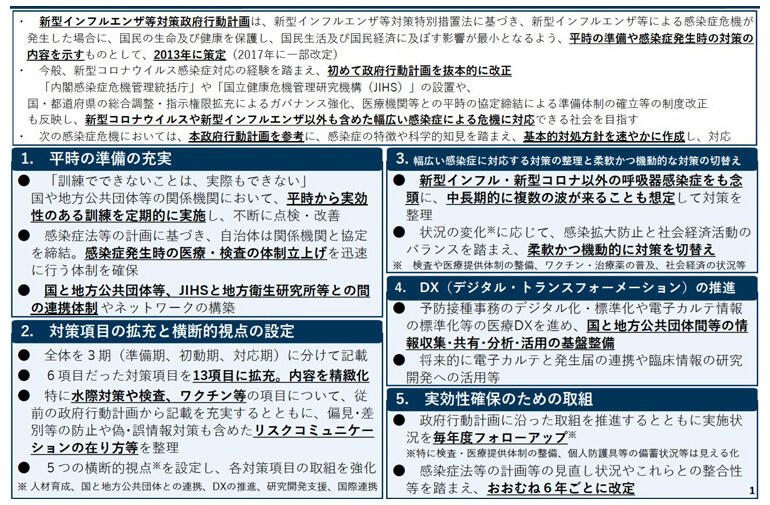
Provided by the Cabinet Agency for Infectious Disease Crisis Management
Clarifying national and prefectural coordination and direction
The first domestic case of the COVID-19 was confirmed in January 2020. After the subsequent pandemic, the classification of the disease was changed to Class 5 under the Act on the Prevention of Infectious Diseases in early May 2023. So far, the country has experienced 10 waves of infection. Approximately 33 million people were infected in the country before the classification change under the aforementioned Act. The number of cases has continued to fluctuate since then, and the waves of infections have not yet subsided.
In regard to the three yearlong COVID-19 pandemic, before its transition to Class 5, the new plan recalls that "the pandemic affected all aspects of the society, posing a major threat not only to the lives and health of the public but also to the stability of national life, including the economy and social life."
COVID-19 has killed over 70,000 people in Japan. During the pandemic, there was some confusion over various responses and measures. A particular issue was the declaration of a state of emergency by the government. At the peak of the pandemic, it was difficult to find hospitals to take patients and they frequently died at home or in care facilities. There were also situations where the government's response was delayed, and public health centers were overwhelmed.
The new plan clarifies how the national and prefectural governments should provide comprehensive coordination and direction. The "Role of the National Government" clearly states that "the national government as a whole has the responsibility to develop a complete system." It also stipulates government responsibility for the early development and securing of vaccines, diagnostic reagents, and therapeutic agents.
Prefectures are requested to conclude agreements with medical institutions in normal times in order to secure hospital beds, provide outpatient care for fevers, and provide medical care for homebound patients. The purpose of such agreements is to enable prompt responses to "infectious disease emergencies." The new plan also defines that municipalities are "the administrative unit closest to residents." Municipalities are requested to cooperate with prefectures and neighboring municipalities to appropriately provide vaccinations and support for people in need of assistance.
There was also some confusion regarding the provision and broadcasting of information. One of the new plan's 13 items is "Providing and sharing information and risk communication." Like the other items, it defines actions to be taken in the "Preparation," "Initial action," and "Response" phases. For example, with regard to bidirectional communications at the Preparation phase, it states that "to ensure appropriate risk communication, the government will develop a system to monitor the spread of false or erroneous information and understand the reactions of the recipients of information." It also calls for the development and expansion of government call centers.
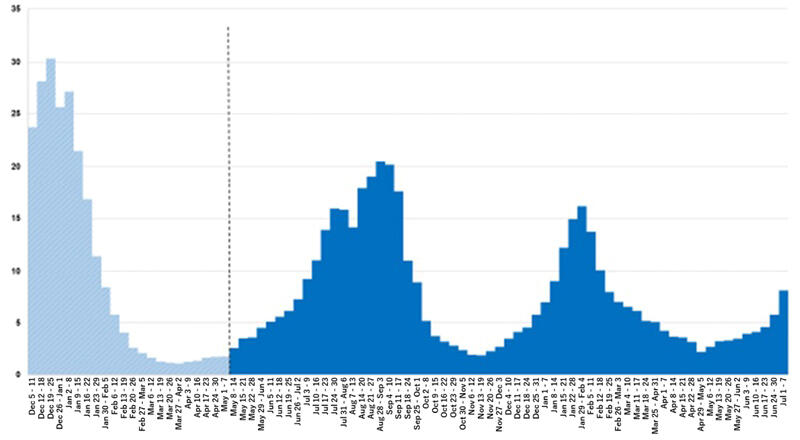
Provided by the Ministry of Health, Labour and Welfare
COVID-19: pandemic that involved the whole nation
The COVID-19 pandemic was the basis for the development of the new plan. It summarizes, "All citizens were involved in the pandemic in various positions and situations. This highlights the importance for society to respond to the pandemic as a whole." It also emphasizes, "The infectious disease crisis did not end with the response to COVID-19, and the next pandemic will surely occur in the future."
The pandemic caused a medical emergency because of inadequate advance preparation based on the government's Action Plan. The new plan was formulated based on this reflection. However, some experts criticize it for not having adequately looked at the response to the COVID-19 pandemic itself. Even after the new plan in place, individual verification is required to be done as necessary.
In September 2023, as a countermeasure against infectious diseases, the government established the "Cabinet Agency for Infectious Disease Crisis Management." The Agency acts as a control tower responsible for the national response to infectious diseases. Additionally, members of the Council for the Promotion of Countermeasures against Novel Influenza, etc., including the Chairperson, were replaced, and the infectious disease system was revamped. In April 2025, the Japan Institute for Health Security (JIHS) will be established to provide scientific advice to the government. In addition to the development of these new mechanisms, the government is of the opinion that a system built around the new plan to prepare for the next pandemic is in place.
However, when it comes to pandemics, balancing infectious disease care against regular medical care is a challenging task. Many clinicians are concerned about the resurgence of COVID-19 and the medical system for new infectious diseases. Shigeru Omi chaired the Promotion Council on Countermeasures until last August. He made more than 100 recommendations to the government through the COVID-19 pandemic. He stated that "While there is no single, absolute right answer to infectious disease control, our goal was to minimize the socioeconomic burden and maximize measures to prevent the spread of infection. It was difficult to find any one right answer when it came to specific measures."
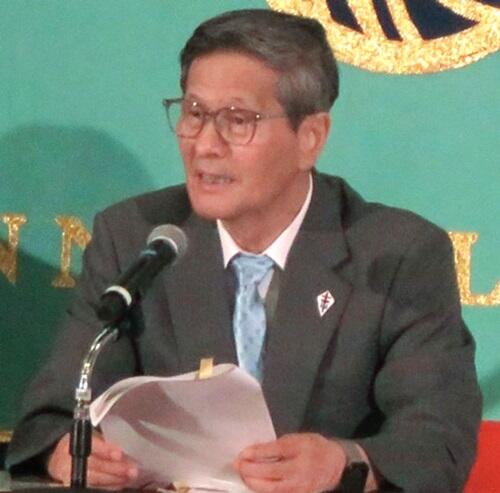
Photo provided by the author
Continuing caution about resurgence
On July 12, the Ministry of Health, Labour and Welfare announced the number of COVID-19 cases reported from approximately 5,000 fixed-point medical institutions nationwide. The number of cases from July 1 to 7 was 39,874. The number of infections per medical facility was 8.07, about 1.4 times higher than the previous week. This was the ninth consecutive week of increase. The number of newly hospitalized patients reported from approximately 500 fixed-point medical institutions nationwide was 2,340. This was also about 1.4 times the number reported in the previous week.
By prefecture, the highest number of infections per medical institution was seen in Okinawa Prefecture with 29.92 cases. This was followed by Kagoshima Prefecture with 23.13 cases and Miyazaki Prefecture with 19.74 cases. The increase in case numbers in Kyushu and Okinawa was conspicuous. On the contrary, the number is low in Tohoku, for example 2.13 in Akita Prefecture and 2.42 in Aomori Prefecture. Hiroshima Prefecture had 6.1 cases; the prefecture issued its own "COVID Medical Stress Alert" on July 11.
Chief Cabinet Secretary Yoshimasa Hayashi said at a press conference on the afternoon of the 12th of July, "I am aware that Hiroshima Prefecture has issued its own warning. There is a gradual upward trend nationwide as well. The government has been informing the public about infection control measures such as cough etiquette and hand sanitization. It is continuing to take appropriate infection control measures while keeping an eye on future infection trends."
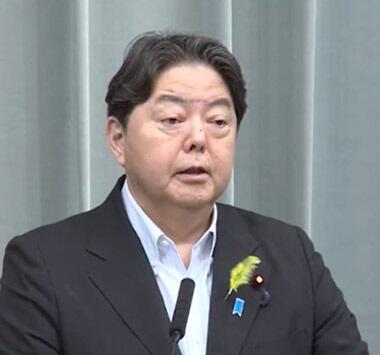
Provided by the Cabinet Public Relations Office
We must prepare for new pandemics and the resurgence of COVID-19, while considering the balance with socioeconomic activities. The task is not easy, but the whole of society has experienced the COVID-19 pandemic and behavioral changes that come with it. We must not forget to examine the past. Meanwhile, going forward, it will be necessary to constantly check the implementation of the new plan and revise it flexibly as required.
(UCHIJO Yoshitaka / Science Journalist, Kyodo News Visiting Editorial Writer)
Original article was provided by the Science Portal and has been translated by Science Japan.




